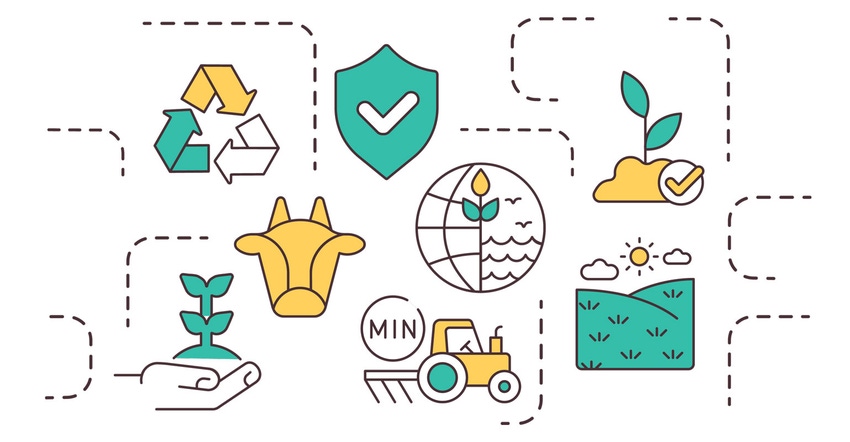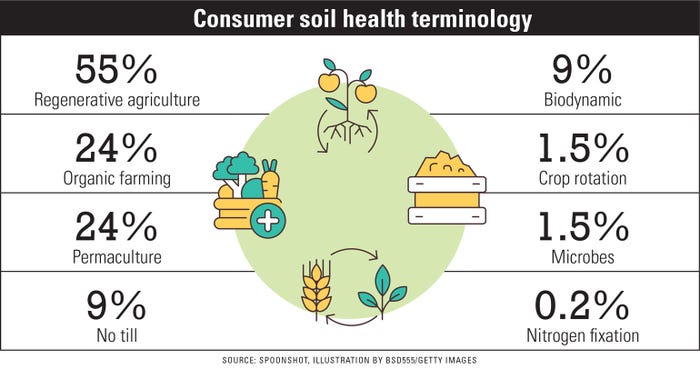November 11, 2022

Consumers associate terms such as climate-smart, regenerative agriculture and crop rotation with soil health, according to a survey by Spoonshot. With so many words to choose from, it begs the question — which one will gain farmers more money in the marketplace?
With the new USDA Climate-Smart Commodity Programs, there is a push for developing markets where farmers find incentives. Still, USDA has not committed to a “brand” per se of “Climate-Smart Commodity.”
In a recent visit with Rob Myers, director of the Center for Regenerative Agriculture at the University of Missouri, about the Climate-Smart Commodity Program and potential moneymaking markets for farmers, he says it is likely to be realized more on how the practices are packaged rather than a brand name. He offered examples for both crop and livestock farmers.
“If it's a soybean farmer that is using cover crops, and then delivering some screening to a facility that's producing soybean biodiesel, there may be an opportunity for that biodiesel to get either a higher price because it's been grown with the cover crops, or maybe to get into a different market than it was earlier because it's got a better carbon score,” he explains. But, he adds, it might just be labeled as low-carbon biodiesel.
The climate-smart packaging is a little less clear on the beef side. Some of the beef farmers involved in the USDA climate-smart projects may be marketing their beef like Missouri cattlemen, under the “grass-fed” label. Myers says this type of marketing may simply expand. It will be more of farmers finding institutional buyers, such as a grocery store chain that needs to offset its carbon footprint.
Big regenerative goals
Companies will also have their say in labeling and incentives for the regenerative agriculture movement. Many are making the push and requiring farming practices that meet their company environment, social and governance, or ESG, goals. Here are a few:
General Mills plans to convert 1 million acres of land to regenerative ag practices by 2030.
Nestle is investing more than $1 billion pounds in the next five years to advance regenerative ag across its network.
PepsiCo will deploy regenerative farming practices across 7 million acres and sustainably source 100% of ingredients by 2030.
Walmart partnered with Midwest Row Crop Collaborative to work with 30,000 farming operations to advance regenerative farming practices across 30 million acres in the Midwest.
But consumers may be the drivers behind company climate-smart word choice, and regenerative seems to resonate with them.
Consumer chatter around food
According to Spoonshot, consumer conversations around soil health as it relates to food production focuses on the following:

Consumers are becoming more ag literate every day — whether on their own or through companies. Either way, they are leveraging it to make food purchases.
Where farmers fit in regenerative marketplace
The upside to the regenerative agriculture movement is, as farmers, you are at the very core. Perhaps it is time you step into the driver seat.
The way you farm matters not only for feeding the world, but also to companies and consumers. Now is the time to leverage it.
Do research on how companies are entering the climate-smart arena. Find where your operation fits their needs, and then start a conversation. While many biodiversity and climate-smart incentives are out there, I’d suggest looking at individual company pages — perhaps those you already do business with.
For instance, I did not realize that The North Face is working with Indigo Ag, offering cotton farmers a premium on their product as well as carbon credits if they deploy regenerative agriculture practices that store carbon and restore soil health. The company considers it less conventional farming and more carbon farming.
With companies continuing to look for ways to meet ESG goals, this seems like one area where farmers can drive the conversation, fill the need and realize financial benefits.
You May Also Like




